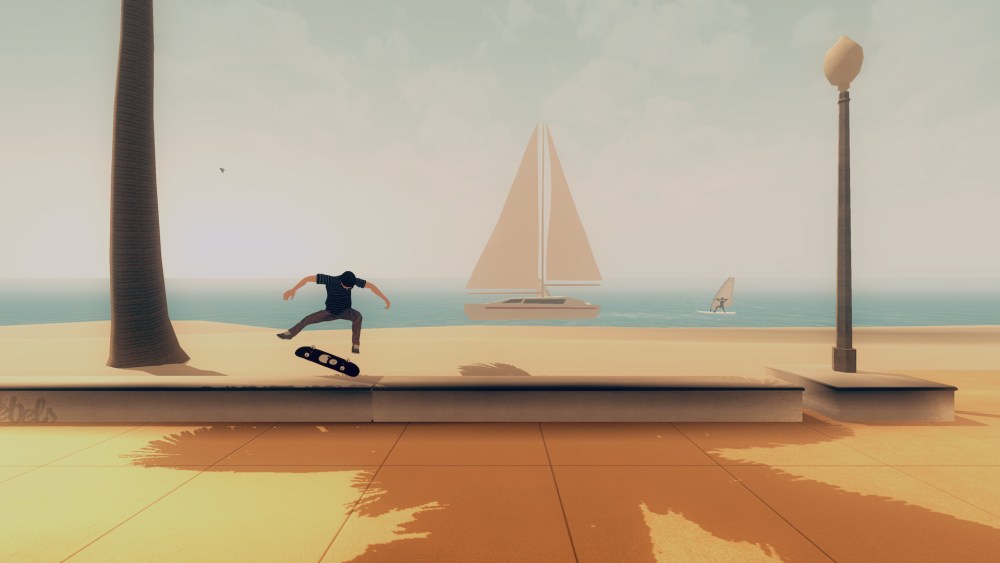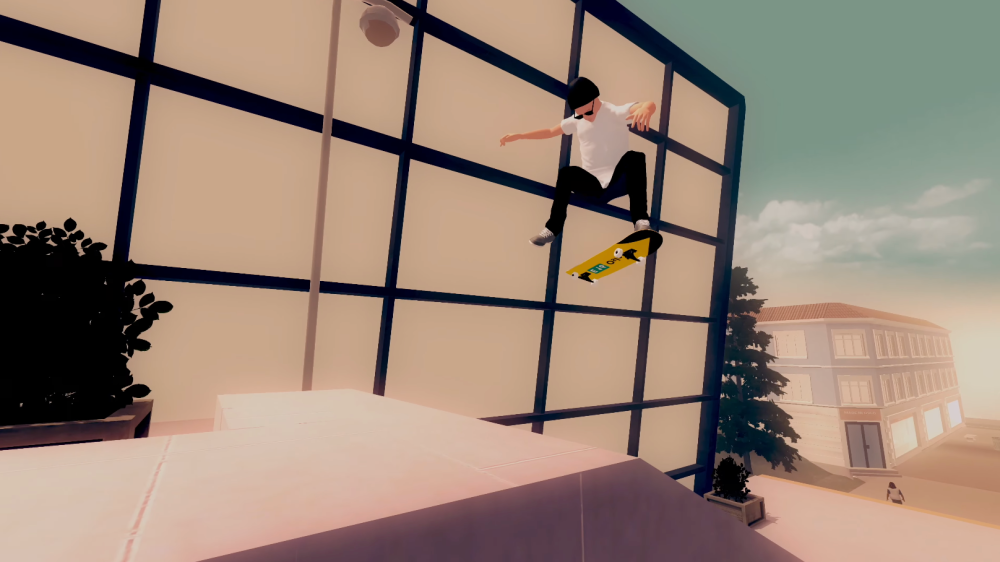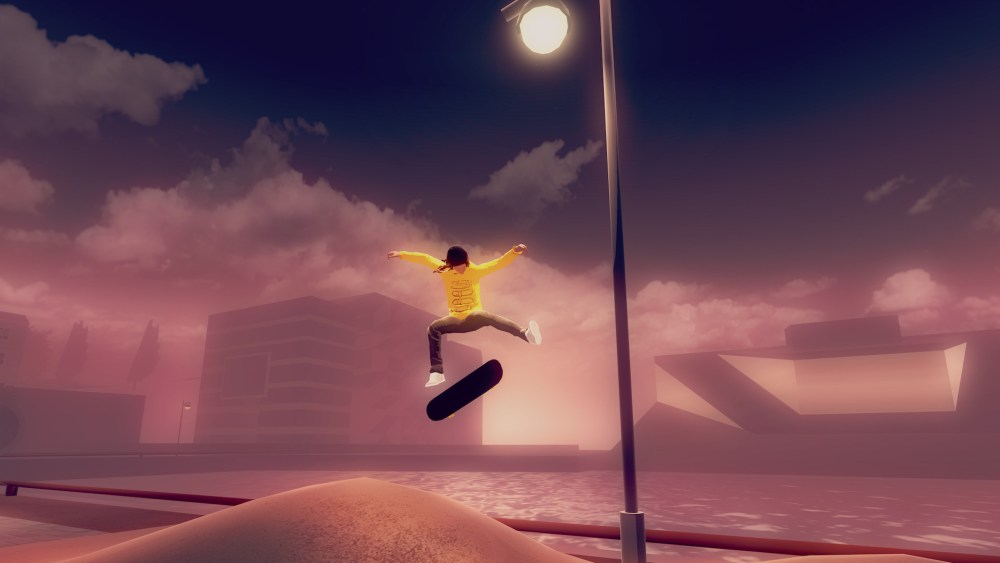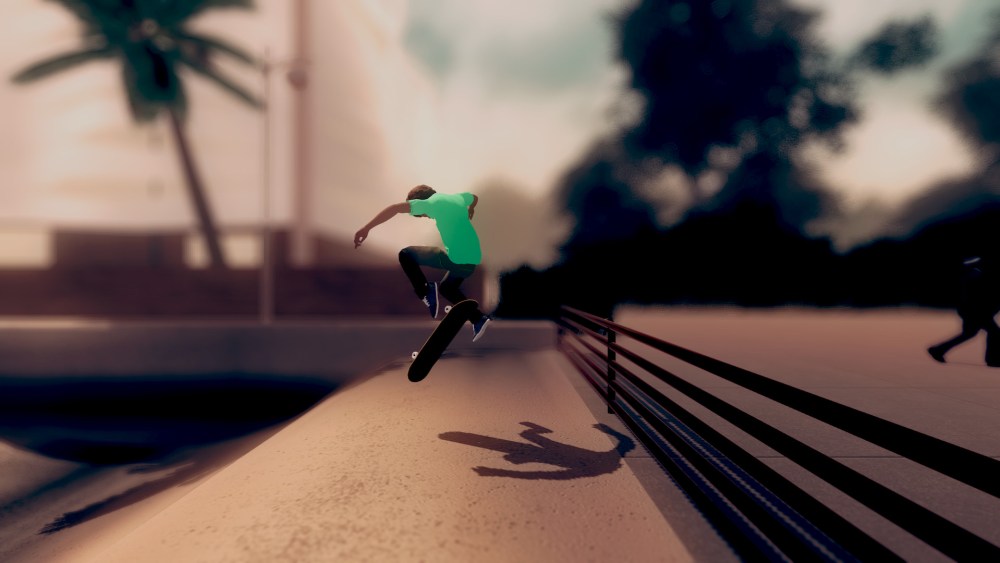Any skateboarding video game created after 1998 will inevitably have to answer the question, “how does it compare to Tony Hawk?” That’s not a knock on any one game, it’s just that the sport’s biggest-ever star changed even the larger gaming landscape. The beauty is that Skate City is very much what Tony Hawk is not. THPS is about blasting high-energy music, lightspeed reflexes, and subsequent in-game challenges to try and out-absurdist its predecessors. Skate City is a delightfully relaxing and calming skateboarding experience that beckons replays with its easy-to-learn controls, smooth gameplay, and mesmerizing soundtrack. The trouble is that it is simply way too short. Let’s talk about that and more in this Skate City review for the Nintendo Switch.
Skate City Review
Skate City is a side-scrolling skateboarding game in which you skate left to right across the screen achieving objectives. Tricks are mapped to the joysticks, spins to L and R, and manuals to ZL and ZR. It played great handheld and played great docked, with no complaints about either method.
There are two ways to play: an “Endless Skate” mode that operates as a looping Free Skate, and then there are challenges for each level. Challenges can be retried and reset almost immediately. There’s an easy camera feature, and in Endless Skate you can easily rewind or fast forward to retry a spot you enjoyed or missed.
Though the name of the game is divine relaxation via skateboarding, your trick list is slim compared to the rest of the genre. You can grind and manual to extend combos, but the 900s, Kickflip McTwists, and even Quad Heelflips of THPS lore are not what Skate City is about. This realism really makes for soothing sessions, especially when your skater is comically and violently thrown (with ragdoll physics) to the ground when you hit an object or mistime your landing. It would jolt me out of a meditative playthrough, but it was almost always hysterical.
What I Like
Relaxing Atmosphere
Let’s focus on a fairly basic trick, a 180 kickflip. How many times have you landed that in THPS? Ollie, hold left, and tap the corresponding console equivalent flip trick button. It’s easy to throw into combos, not worth a lot of points, fairly boring of an animation considering the rest of the THPS trick compendium, and it’s largely taken for granted considering the actual beauty that goes into the trick.
However, in Skate City, landing the exact same trick feels so natural and poetic, soaring through the air with perfect spin on both the board and the skater. You land it and it feels wonderful, scratching an itch in the same way that having the exact amount of tomato paste for a recipe and perfectly squaring up a softball at the batting cages do. This, ultimately, is the foundation of the Skate City experience. The challenges are there, and it is certainly fun to try and stretch out some long combos, but the game is totally content with players skating across the screen and doing whatever they want to relax them.
The Soundtrack
In tandem with the relaxed pacing, the game’s lo-fi hip-hop soundtrack is exquisite. The game absolutely, 100% must be played with sound on to get the full experience. Fans of MF Doom, J Dilla, and other similar producers of that era will adore the easygoing beats that immeasurably amplify enjoyment of Skate City. That was when I found the game to be at its very best: a great instrumental with a BPM that perfectly complemented the speed of my challenge progression, hitting every flowing trick as I went along.
Huge congratulations and praise go out to Buster Jenkins, Granbar, Peer Synth, and the rest of the artists who contributed to the soundtrack.
What I Don’t Like
Short Length And Lack Of Depth
Skate City only has three levels, and unlike the THPS series, there is not a ton of tremendous variance between each level. Many of us can remember the first time we dropped into the expansive School in THPS after conquering The Warehouse, a superb example of how different environments can shape different skateboarding journeys altogether. But, regrettably, I did not get that same feeling going between Los Angeles, Oslo, and Barcelona.
It is very easy to rack up Skate Cred (in-game currency, “SC”) to unlock the other two levels, and after multiple runs to finish off challenges, I grew weary of the levels. It was almost as if the game was trying to tell me, “Okay, you’ve had your 20 minutes of immersion and relaxation, time for you to get back to the rest of your day.” I suppose that brevity in playing benefits other folks looking for a shorter break in their day, but I was disappointed to get hit with that feeling during my playthroughs. There is no career mode, story mode, or anything of the like, further emphasizing how important it is for the gameplay to resonate with and relax players.
I also struggled a bit with the game’s camera angle at times, especially when there were opportunities for both grinding a rail and shooting a gap in the same spot. There was no way for me to tell the game to avoid or select the rail or ledge. Instead, I would just ollie and hope for the best. Additionally, more often than not, I would find myself wanting to skate a decorative rail or ramp that was off of the level’s horizontal plane. Sometimes I would even try and aim my skater over in that direction, only to forget that I did not have that sort of freedom and instead launched into a flip trick.
Limited Customization
There is a Skate Shop providing players with the textbook customization suite to tweak their nameless protagonist. However, it is exceptionally barebones: five hairstyles, a few hats, some trucks, and pretty standard clothing. The only physical feature you can change about yourself is your skin color, and after a few moments of “oh, is that really it?” I found myself never returning to the Skate Shop. Gold skate trucks, which would hardly be visible in the main game anyway, cost over 17K SC, while the other two levels cost only 2.5K and 4K.
For a game lacking licensed gear, the Skate Shop regrettably feels like a missed opportunity. You can only wonder what could have been if it had been fleshed out to provide some unique identity, creative grinding, or clever rewards to further encourage progression.
Bottom Line
Skate City is certainly worth checking out. Its gameplay and ambience are decidedly relaxing, and it is incredibly easy for newcomers to jump in and get acclimated. The perspective and controls might take a minute to get adjusted to, but it is still a title with plenty of challenges and replay potential to keep players busy, especially with its A+ soundtrack. However, you have been warned about its brevity and lack of depth. That being said, it’s $14.99 USD on the Nintendo Switch, so it is a budget title.












Published: May 27, 2021 02:50 pm